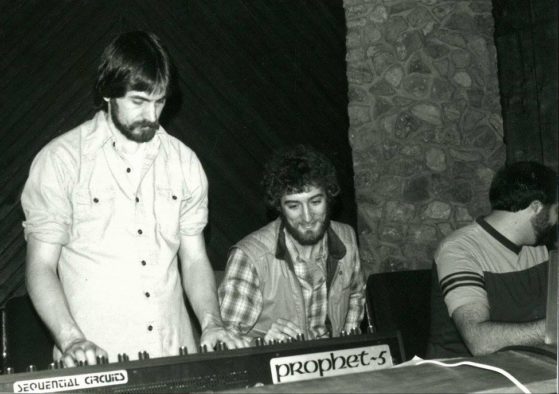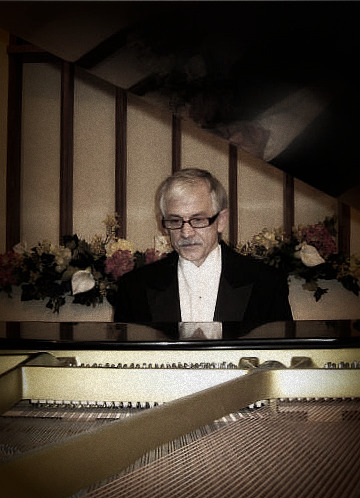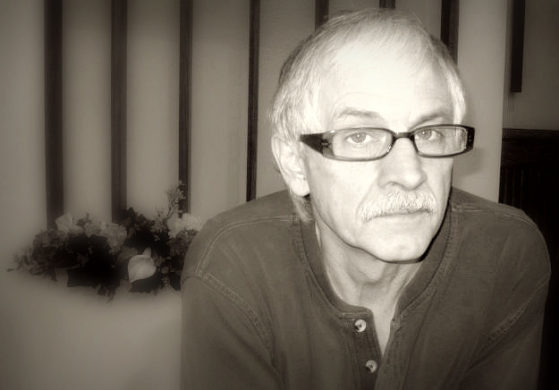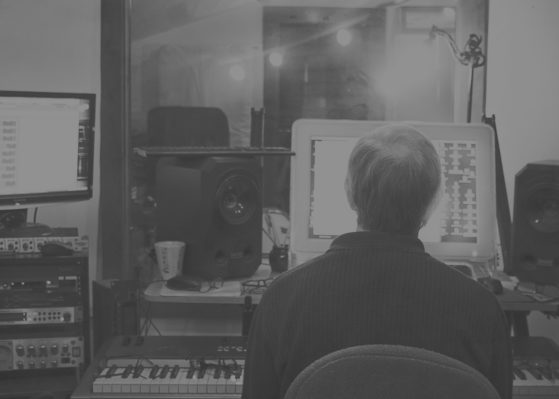Biography
Steve can juggle seven monkeys while driving a taxi… through the ocean.
I was born in Seattle and grew up in Bothell, Washington in what used to be a small burg north of Seattle. I was the youngest of 5 children and consequently hopelessly spoiled.
My musical training began with piano lessons at 6. My mom tells me I was singing the alto part to hymns before I could read the words. However, someone noticed my beautiful yet piercing voice and made a comment to my mom about it while I was present. Thus ended my singing career until college.
Growing up I could listen to any note or chord and instantly play it on the piano. I don’t remember ever not being able to do that. Such is the nature of perfect pitch – you can’t work at it, no matter what that cheesy guy in the trade mag adverts tells you. You come that way from the factory, although my friend Patrick Fata thinks all babies are born with it, but it’s lost early on.
He may be right. I’ll be writing an article about perfect pitch becoming not-so-perfect, a phenomenon that has kicked me squarely in unpleasant musical places over the last few years.
The next few paragraphs are about my college years and immediately thereafter. You might want to skip down (to the end?) unless you’re my mom or a long-lost friend. Seriously, we don’t usually track how long you stay on this page….
 I Graduated from Cedarville University in 1974, with a degree in music performance and theory, traveling the country singing and playing with Selah, one of several bands by that name over the last few decades. The band broke up in 1978, 3 months after I married Mary Wood. It was sort of a Yoko thing.
I Graduated from Cedarville University in 1974, with a degree in music performance and theory, traveling the country singing and playing with Selah, one of several bands by that name over the last few decades. The band broke up in 1978, 3 months after I married Mary Wood. It was sort of a Yoko thing.
I began to have a few opportunities to play keyboards and produce at Pinebrook studios in Alexandria, Indiana, and though it was clearly not worth the drive for the money I made, I was intrigued by the recording studio and continued to drive back and forth. By 1981 I was getting more chances to work at what is now called Gaither Studios. Mary and I, with 9 month old Emily in tow, moved to Indiana to a location between Pinebrook, Mary’s childhood home (and other family members in Kokomo), and Indianapolis, where I was getting occasional work with ASA productions as a player and occasional jingle writer. Truthfully, to say I was a jingle writer is a bit euphemistic – I tried writing a few, and produced some demos, but I’m not sure I actually sold any.
I had not considered a career in music production, arranging, playing, and songwriting, until these opportunities presented themselves in the late 70’s and early 80’s. I recall upon meeting Mary’s parents, her mom asked her (not within earshot) if I was planning to get a real job. Sadly, I never did. I suppose part of the concern was my disheveled and eccentric appearance; I was in the habit of not tying my shoes, my coat was some old man’s cast-off I had found, and my clothes were not shall we say well-coordinated. I had longer hair and a beard, which at
that time to conservative, God-fearing Baptist parents, was not a good omen, to put it gently.
I continued to get more gigs at Pinebrook, producing and arranging albums for a variety of mom and pop groups, various quartets and trios, and solo artists. I was not a quick learner at the art of arranging, nor at understanding how a rhythm section functioned. But I had perfect pitch and could tickle the ivories quite well, and that was good enough to get me more producing work.
 In 1982 or 1983 I was producing a record for a christian band, whose name escapes me, and a young aspiring songwriter and artist named Ray Boltz came to the session to watch it go down. He was impressed enough to ask me to produce his first recording. He was a local artist with a bent for storytelling, and sang at various functions, including prisons and retirement homes. His first recording included a 6 or 7 minute song entitled “Watch The Lamb.” Neither of us knew anything about the Christian recording industry, or how to make a hit record. We simply tried to make his songs interesting and to our liking.
In 1982 or 1983 I was producing a record for a christian band, whose name escapes me, and a young aspiring songwriter and artist named Ray Boltz came to the session to watch it go down. He was impressed enough to ask me to produce his first recording. He was a local artist with a bent for storytelling, and sang at various functions, including prisons and retirement homes. His first recording included a 6 or 7 minute song entitled “Watch The Lamb.” Neither of us knew anything about the Christian recording industry, or how to make a hit record. We simply tried to make his songs interesting and to our liking.
His sophomore effort, “Thank You,” was distributed by Diadem Records out of Nashville. Interestingly, the record was shopped to some major Christian labels who seemed to think he could be a songwriter, but probably wouldn’t have a successful career as a Christian artist, at least at that time. They didn’t quite get it right. Thank You was a #1 song on both the AC and Inspirational charts, staying on top for quite a few weeks, and becoming the Gospel Music Associations’s Song of the Year.
Shepherd Boy was the next single from that album; it likewise went to #1 on both Inspo and AC charts. Bill Gaither owned half the publishing to some of Ray’s songs, and published an ill-fated musical entitled “Thank You.”
As a studio keyboardist, my background as a classical pianist was helpful in developing an accurate technical approach. Having little experience playing in bands (Selah was my only foray that direction), I was rather slow to get into the synthesizer world. My first synth was a DX-7; I never learned to do in-depth programming, being satisfied with the sounds that came out of the box on their own with some simple modifications. My greatest area of interest and skill gradually became the world of piano and orchestral samples; I use many orchestral samples extensively in my arrangements and productions. This is partly because of financial constraints, but also because when trying to complete arrangements as much as possible in my home studio, it was often impossible to get them to feel like music without some of the necessary orchestral elements. Recently I’ve added a program for strumming acoustic guitar that sounds a bit shaky on it’s own, but buried in the mix or as a mock-up tool works decently.
Looking back, some of those first sampled instruments were really nasty sounding. I remember buying my first Proteus 2 for some of the woodwinds and a few other instruments that I thought sounded pretty good. Today I can still pick out that painful, flat, lifeless, one dimensional sound of the Proteus 2 oboe when I hear it, generally in muzak. I can be in a crowded restaurant, music barely audible, but that sample always catches my ear and makes me want to run screaming from the room.
I’ve taken some rabbit trails in this riveting extended music history of my life, and even my mom would probably have given up by now, but I plod on, determined to finish this breathtaking biography.
 My home studio (ZooWest) came into being circa. 1990. The recording medium known as ADATs had been developed, and eventually, I decided it might be doable to record at least a few of the demos or overdubs I was doing at my own facility. As you might imagine, I slowly added to the gear that I owned, and within a few short years had a fairly functional ADAT based studio. Might I add that while ADATs became somewhat standard in most studios, it was a very imperfect and not-so-pleasant technology.
My home studio (ZooWest) came into being circa. 1990. The recording medium known as ADATs had been developed, and eventually, I decided it might be doable to record at least a few of the demos or overdubs I was doing at my own facility. As you might imagine, I slowly added to the gear that I owned, and within a few short years had a fairly functional ADAT based studio. Might I add that while ADATs became somewhat standard in most studios, it was a very imperfect and not-so-pleasant technology.
It was probably near the end of the 90’s when I took the leap into the world of Pro Tools. I’d like to apologize to all my engineering friends who patiently answered my plethora of questions for a few years as I struggled to come to terms with this new way of recording. Though I didn’t quite get the way that it interfaced with our analog world, I was entranced and thrilled with this new, non-linear approach to recording and especially editing, and have never looked back. No matter that I didn’t have the logical thinking processes of some of my brilliant keyboard compatriots – I was able to make it do essentially what I wanted it to do, though often there was a better way than the one I chose.
When we decided to add the music studio to our home, I was thinking of it simply as a room to keep the piano and where I would do some arranging. Fortunately, we decided at the 11th hour to attach a small bathroom to this large room, and the room was large enough that many years later, when I decided it would be useful to separate into two areas, one for the singers and instrumentalists, and the other for
the control room, there was adequate space. Joe Rushton, a good friend, agreed to build the wall between the 2 rooms, and he just happened to have a rather large, double thickness window sitting out in his yard (!) which he agree to install between the 2 rooms, regarding the “overdub” room as it now known, though it is not very spacious, it works quite nicely for recording, due to a generous amount of sound treatment, and a cathedral ceiling which lets the room breathe and means that at least 2 of the primary surfaces are not parallel. I did know enough to have the glass between the control room and overdub area installed at a slight angle to prevent the nasty results you will often get in a room with too many parallel surfaces.
I have been fortunate to work with Hal Leonard Publications out of Milwaukee in many different ways over the years. First as a studio player in the earliest years of my acquaintance with them, and later as an arranger and producer. As a player, there have been a couple ongoing projects I’ve worked on with them – their Essential Elements recordings, and the musicals for young children that have been for many
 years produced by John Higgins. If anyone is still reading, you might find it interesting that John Higgin’s co-writer for these musicals was John Jacobson, who has achieved internet fame largely due to a viral youTube video from a few years back affectionately know as Double Dream Hands.
years produced by John Higgins. If anyone is still reading, you might find it interesting that John Higgin’s co-writer for these musicals was John Jacobson, who has achieved internet fame largely due to a viral youTube video from a few years back affectionately know as Double Dream Hands.
There was a rather monstrously large project a few years back for Uncle Hal, a collaboration with MacMillan McGraw Hill on new music textbooks for many of our nation’s school children. They employed me, as well as some others, to produce the music that would be used in the classrooms to educate children and help teachers with that task. I believe I was responsible for about 125 of the songs for that project, and my family will attest to the fact that I should either have attempted less of them, or hired some additional help; I was in way over my head for 6 months or so.
It has only been a little over a year since I began attempting to create and sell music via the internet. Again, I’m a little slow to get into the game. The initial site was weddingmusicproject.com; my son Jesse is the programmer and nephew Brian is the SEO guy and collaborates with Jesse on site design and functionality. Site visitors have enjoyed Storybook Love, the Theme from Princess Bride, and a few dozen other tunes I’ve released. One of our albums is 20+ versions of the traditional Wedding March|Bridal Chorus|Here Comes The Bride; the traditional pipe organ version seems to be the preferred version so far, though I favor the gentle piano version or the solo violin with piano and orchestra. I’m preparing to release some more uptempo tunes; some of them would make creative processionals or recessionals.
Since we started on that little adventure, I’ve been buying up domain names and developing other websites. You can find some of my lullabies at babylullabymusic.net; there are a few others that are in their infancy, and within a few months will be on the broadcast in some form.
I won’t list my recording studio gear except to say I’m using a Pro Tools HD2 system with stellar Mytek A-D conversion. On the virtual orchestra front, I use EastWest’s Platinum Quantum Leap Orchestra, Vienna Instruments from VSL, and the factory library included tihe the Kontakt player.
